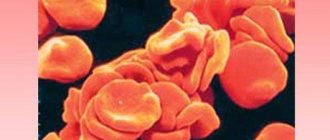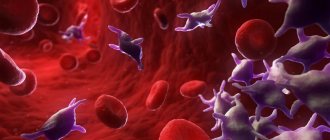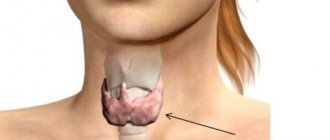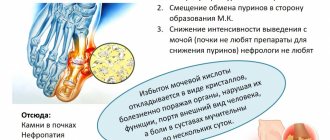MPV (short for mean platelet volume) is the designation of the platelet index, which characterizes the degree of platelet maturity in peripheral blood. The measurement is based on the fact that the size of young cells is larger than that of mature and aged cells. There is a connection between the size of platelets and their functional activity, so the index characterizes the state of the blood coagulation system, which platelets represent.
Determination of MPV in a general blood test is carried out within two hours after collecting the material, since with a later study the result may be distorted.
General blood analysis
A complete blood count (CBC, clinical blood test) is one of the most important and frequently prescribed laboratory tests. This analysis makes it possible to assess the condition of the body as a whole, confirm or exclude the suspected diagnosis, and monitor the progress of treatment.
Platelets are blood cells that stop bleeding if a blood vessel is damaged.
The first general blood test is performed for children in the maternity hospital. As the child grows up, it is recommended to carry it out regularly during routine medical examinations, which will make it possible to promptly identify abnormalities (for example, the development of iron deficiency anemia) and take the necessary measures in a timely manner. For preventive purposes, it is recommended to conduct a general blood test for adults once, and for children twice a year.
A general blood test includes determination of hemoglobin concentration, number of red blood cells, white blood cells and platelets, hematocrit level, as well as erythrocyte and platelet indices and erythrocyte sedimentation rate. A detailed blood test also includes a leukocyte count, which consists of determining the percentage of different types of leukocytes in the peripheral blood.
Counting the number of platelets and determining MPV is mandatory for women during pregnancy, as well as for patients with autoimmune diseases, varicose veins, liver pathologies, etc.
Increase P-LCR
An increased number of large platelets means that there is a pathology in the body. Only in isolated cases is a high P-LCR value an individual characteristic of a person and does not require treatment.
Etiology
The reasons for an increase in P-LCR can be completely different diseases - inflammatory, oncological, hematological, infectious.
Along with this, the P-LCR index increases if the patient has:
- infectious pathology - bacterial, viral, fungal, parasitic,
- post-traumatic and postoperative syndrome,
- oncological and hematological diseases - lymphoma, neuroblastoma and hepatoblastoma, anemia,
- spleen diseases,
- cirrhosis or polycystic liver disease,
- damage or inflammation of the spinal cord,
- alcoholism,
- intoxication with chemicals that disrupt bone marrow function,
- atherosclerosis,
- diabetes mellitus
A high P-LCR index leads to the fact that the patient has a tendency to thrombosis. Due to the adhesive properties of platelets, they stick together and form a blood clot, which disrupts blood circulation and prevents the free movement of blood. As the thrombus grows, it narrows the lumen of the vessel, disrupts the blood supply to the organ, and causes hypoxia and ischemia of the tissue. When the coronary arteries are damaged, this leads to myocardial infarction. With thrombosis of cerebral vessels, an ischemic stroke develops. The result of the process is often varicose veins or atherosclerotic changes in the arteries. These pathologies are deadly and often result in the death of patients.
Symptoms
When the P-LCR increases, the patient develops corresponding clinical signs. They may go unnoticed behind the obvious symptoms of the causative disease. Such patients are not treated for thrombocytosis, which further aggravates the situation.
An increase in P-LCR is manifested by the following symptoms:
- hypersensitivity and pain in the fingertips,
- causeless appearance of hematomas,
- irritation and itching of the skin,
- cyanosis,
- asthenia of the body,
- rapid heartbeat,
- shortness of breath at rest,
- visual dysfunction.
These signs are optional. They can appear individually or in various combinations. But despite this, the patient needs to visit a health care facility and undergo certain tests, based on the results of which doctors will determine the cause of the P-LCR deviation and prescribe appropriate treatment.
Treatment and diagnostic procedures
To determine the cause of the disorder and make a correct diagnosis, in serious cases, a bone marrow biopsy is examined and blood is taken again. Additionally, general clinical and molecular tests and ultrasound of internal organs are performed.
To normalize the P-LCR value, the causative disease must be eliminated. If the pathology is not treated, the patient risks dying from thrombosis, or more precisely from its consequences - acute coronary or cerebral failure. These phenomena are very dangerous. They are often fatal. That is why this deviation needs to be corrected. Hematologists carry out diagnostic and treatment measures. Restoration of normal P-LCR levels in a blood test is a sign of adequate and effective therapy.
- Patients are prescribed a diet rich in vegetables and fruits, vegetable oils, freshly squeezed juices and other products that make the blood less viscous. For the same purpose, experts recommend optimizing your drinking regime - drinking up to 2-3 liters of water per day.
- To prevent thrombosis and its consequences, the use of antiplatelet agents and anticoagulants is indicated - Aspirin, Cardiomagnyl, Trental, Cavinton, as well as drugs that improve microcirculation - Dipyridamole, Piracetam, Vinpocetine.
- If the cause of a high level of large platelets is an infectious disease, then after intensive antibiotic therapy, the P-LCR index value returns to normal almost immediately.
- In severe cases, the use of corticosteroids - Prednisolone, Dexamethasone and cytostatics - Anagrelide, Hydroxyurea, Radioactive phosphorus 32P is indicated.
- To stimulate the immune system, Interferon and its derivatives are prescribed.
- There are folk remedies that allow you to correct (but not eliminate) existing violations. These include: mulberry poison, sweet clover infusion, ginger tea, celery juice. These plants have a beneficial effect on the condition and activity of platelets.
Platelets, their types and functions
Platelets (PLT, platelets) are blood cells with a diameter of 2-4 microns that provide blood clotting. The functions of platelets include angiotrophic (the ability to maintain the structure and functions of the walls of microvessels), adhesive-aggregation (formation of a primary platelet plug in damaged blood vessels), platelets are also involved in fibrinolysis, maintaining vasospasm, and blood clot retraction. These blood cells have the ability to transport circulating immune complexes on the membrane.
An increase in MPV may indicate the presence of thrombocytopenia, myeloproliferative diseases, posthemorrhagic anemia, hyperthyroidism, and diabetes mellitus.
There are five forms of platelets: young, mature, old, irritable and degenerative.
Platelets, like other blood cells, are produced in the bone marrow. Approximately two-thirds of the total number of platelets is in the bloodstream, and one-third is in the spleen. The precursors of platelets are megakaryocytes - giant cells with a large nucleus, from which platelets are released. Platelets are fragments of the cytoplasm of megakaryocytes surrounded by a membrane. They do not have a nucleus and their lifespan is approximately ten days. Platelet granules contain clotting factors, serotonin, calcium ions, adenosine diphosphate, peroxidase, platelet growth factor, von Willebrand factor, etc.
Platelets are round or oval in shape. When a blood vessel is damaged, they are activated, the cells flatten, form pseudopodia (long outgrowths) and acquire the ability to stick to other platelets (aggregation) and the walls of the damaged vessel (adhesion). A blood clot forms, which blocks the damaged area and thereby stops bleeding. Stimulators of platelet aggregation include serotonin, thrombin, collagen, and adrenaline. In a normal (inactive) state, the platelet membrane does not support coagulation reactions. There is a connection between the size of platelets and their functional activity, the content of biologically active substances in their granules, and their tendency to adhere.
Normally, the number of platelets in the blood is 180–320 × 109/l, varying depending on the time of year and time of day (daily fluctuations can reach 10%). A physiological increase in the number of platelets in the blood occurs when rising to altitude, in winter, after injury or exhausting physical activity. A physiological decrease in platelet count is observed before and during menstruation (up to 25–50%), as well as during pregnancy.
A significant decrease in MPV in the blood of a pregnant woman indicates a threat of miscarriage.
When the balance between the formation and destruction of platelets is disturbed, a tendency to thrombosis or increased bleeding occurs. With an increase in the number of platelets and the development of thrombosis, there is a risk of pulmonary embolism, stroke, myocardial infarction, and blockage of blood vessels in other organs by clots. A decrease in the number of platelets leads to hemorrhages and bleeding, which can also cause the development of life-threatening conditions.
The counting of platelets in the blood is carried out using an automatic hematological analyzer; in some cases, there is a need to determine the number of platelets and their sizes in stained blood smears under a microscope when calculating the leukocyte formula.
Platelet indices of a general blood test include:
- mean platelet volume (MPV);
- platelet distribution width by volume (PDW) – an indicator of platelet anisocytosis (depending on the predominance of young or old forms in the blood);
- thrombocrit (PCT) - indicates the proportion of blood volume occupied by platelets (depending on the total number of platelets and the MPV index).
Platelet indices allow you to assess the state of the blood coagulation system
Treatment
If the test shows that your platelet level is below normal, you should undergo testing to find out the reason and decide how to increase your level. Treatment depends on the cause of this condition and is aimed primarily at eliminating it.
If the low platelet count is due to medications, they are discontinued. If severe bleeding occurs, platelet and plasma transfusions are performed. With significant blood loss and the development of severe anemia, transfusions of red blood cells and plasma may be required. To increase platelet production and suppress autoimmune reactions, immunoglobulin and corticosteroids are prescribed.
If there is no desired result with conservative treatment of thrombocytopenic purpura, heavy repeated bleeding, hemorrhages in important organs, splenectomy may be indicated - an operation to remove the spleen, the effectiveness of which is high (about 80%).
For thrombocytopenia, in order to strengthen the walls of blood vessels and increase blood clotting, a course of medications based on natural ingredients can be prescribed. These include products such as Derinat, Sodecor, and Etamzilat.
If your platelet count is low, doctors recommend eating right. It is necessary to avoid alcoholic drinks, hot and spicy foods. The menu should include more foods rich in vitamins A, C and promote better blood clotting. These are liver, fish oil, chokeberry, bell pepper, celery, green apples, parsley, rose hips, carrots, peanuts, pine nuts, almonds, grape and lingonberry leaves, birch sap.
In addition to proper nutrition, doctors recommend adhering to a healthy lifestyle, maintaining a daily routine, getting enough sleep, and not overexerting yourself physically and psychologically.
Video about the functions of platelets and the reasons for the decrease in their number in the blood:
Preparation and delivery of a general blood test
To take a general blood test, standard preparation rules are used. Blood sampling is carried out in the morning on an empty stomach. On the eve of the study, you should avoid excessive physical and mental stress, and give up fatty foods. Before donating blood, you should not smoke; the patient should be completely at rest for half an hour before the test. Blood for general analysis can be taken either from a finger or from a vein.
Determination of MPV in a general blood test is carried out within two hours after collecting the material, since with a later study the result may be distorted.
A decrease in MPV may mean an enlarged spleen (splenomegaly), the presence of liver cirrhosis, hypoproteinemia, kidney disease, and thyroid pathologies.
Folk remedies for the treatment of low platelet count
If you want to get rid of thrombopenia, you can use folk remedies (if the decrease is not associated with illness). For therapy, various natural ingredients are used, products that stimulate the production of platelet plates.
Sesame oil
Sesame oil makes good progress in the treatment of thrombopenia. You need to choose virgin oil, consume 1 tablespoon 2-3 times a day for 2-3 weeks. It is advisable to consume the product 30 minutes before meals.
Sesame oil is recommended because of its rich composition. Contains microelements:
- omega-3;
- vitamin E;
- lignans.
Sesame oil
When consumed orally, in addition to increasing platelets, it is possible to improve digestion, increase immunity, strengthen the cardiovascular system, and reduce the level of bad cholesterol. The product has virtually no contraindications for use. Long-term use is possible.
Nettle for thrombocytopenia
If a person suffers from low platelet concentration, it is possible to correct the condition using nettle. Decoctions and infusions are prepared from it. You can use the following recipe:
- You will need to prepare 2 tablespoons of dry nettle.
- Pour 200 ml of boiling water over the nettles.
- Let the prepared infusion brew for several hours.
You need to drink liquid 30 minutes before meals every day. The duration of treatment is 3-4 weeks. It is permissible to consume nettle over a long period of time.
Among the beneficial properties are stimulation of the immune system and improvement of metabolism. In addition, nettle infusions and decoctions actually increase platelets. After a certain period of time, their amount in the blood becomes normal. Coagulability improves.
It is important to know! To achieve noticeable results, therapy should continue for at least 2 weeks. After treatment, preventive measures must be taken to prevent the recurrence of thrombocytopenia.
Chokeberry
Rowan has a fairly large number of useful properties. With the help of chokeberry, it is possible to treat uncomplicated thrombocytopenia. The fruit contains many vitamins, nicotinic acid, and flavonoids. To prepare a medicine based on rowan, you can use one of the following recipes.
- Decoction - add 20 grams of fruit to boiling water. After this, you need to cook the liquid for 5-10 minutes. The decoction is consumed daily in small portions of 50 ml. The number of doses per day is 3-4 times.
- Infusion - 1 teaspoon of fruit needs to be poured into 250 ml of boiling water. Then let the liquid brew in a thermos for 5 hours. You need to drink a glass of the infusion every day.
- Jam - you need to take 500 g of fruit, 400 grams of sugar, 20 g of citric acid. The fruits are passed through a meat grinder and covered with sugar. Everything is thoroughly mixed. Add citric acid and other ingredients to taste. Jam is consumed with tea or any other drink.
Appearance of this type of rowan
You can also consume up to 150 g of fresh fruit almost every day for a long time. Using mountain ash you can experiment in different ways. In their fresh natural form, the fruits bring the greatest help. In winter, decoctions are made from frozen fruits.
MPV in a blood test: decoding, norms in women and men
Determination of MPV is important for assessing the hematopoietic function of the body. Using the MPV platelet index in a blood test, you can detect increased platelet aggregation, thrombosis, and active blood loss (if large platelets are detected in people with iron deficiency anemia). In addition, the MPV indicator in a blood test acts as an additional marker of chronic myeloproliferative diseases (the presence of large platelets in the peripheral blood).
The normal MPV in adults is the same for women and men and is 6–13 fl. In children under one year old, the MPV norm is 7–7.9 fl, 1–5 years old – 8–8.8 fl. For children over 5 years of age, the normal values are the same as for adults.
An elevated MPV platelet index indicates the presence of large platelets in the patient's peripheral blood. If the MPV in the blood test is low, this means a predominance of small platelets.
When MPV in a blood test is increased and decreased
An increase in MPV may indicate the presence of thrombocytopenia, myeloproliferative diseases, posthemorrhagic anemia, hyperthyroidism, diabetes mellitus, infectious and inflammatory diseases, neoplasms, preeclampsia, idiopathic thrombocytopenic purpura, impaired platelet formation due to a lack of vitamin B12 or folic acid in the body, May-Hegglin anomaly , Bernard–Soulier syndrome. The index also increases after surgical removal of the spleen (splenectomy), in smoking patients with atherosclerotic changes in blood vessels, with alcoholism and taking certain medications, and in the elderly.
When the balance between the formation and destruction of platelets is disturbed, a tendency to thrombosis or increased bleeding occurs.
What does a decrease in MPV mean?
A decrease in MPV may mean an enlarged spleen (splenomegaly), the presence of liver cirrhosis, hypoproteinemia, kidney disease, and thyroid pathologies. The platelet index decreases in aplastic anemia, septic thrombocytopenia, congenital megakaryocytic hypoplasia, Wiskott-Aldrich syndrome, X-linked thrombocytopenia with platelet microcytosis, thrombocytopenia caused by immunological destruction of cells, as well as during chemotherapy and during pregnancy. A significant decrease in MPV in the blood of a pregnant woman indicates a threat of miscarriage.
Deviations
Deviations appear in the form of increased or decreased indicators.
Reduced values
If the average platelet size is below normal, this means that there is an almost complete absence of cells of normal size in the blood, and it is saturated with small “deflated” platelets that do not perform their direct function. The time to stop bleeding will be clearly increased, but the production of these cells by the bone marrow will be reduced.
MPV may decrease if:
- splenomegaly (pathological enlargement of the spleen);
- liver dysfunction (with cirrhosis);
- anemia;
- hereditary diseases (Wiscott-Aldrich syndrome, etc.).
- some cancers;
- inflammatory processes;
- autoimmune diseases (rheumatoid arthritis, etc.);
- developing myocardial infarction;
- kidney diseases (glomerulonephritis, etc.);
- diseases of the thyroid gland;
- treatment with certain medications (antiviral drugs, etc.).
Increased level
If the MPV norm is exceeded, among normal blood platelets the presence of young large cells and a large number of platelets, the size of which sharply exceeds the norm, will be observed. Such blood cells cannot perform their function correctly. In such a situation, the bone marrow produces blood cells at the limit of its capabilities and blood clotting is severely impaired (there is a risk of developing blood clots).
It happens that such MPV is observed in various physiological conditions, but most often its change indicates the development of a number of diseases.
Physiological conditions with increased rates:
- surgical interventions performed;
- multiple injuries;
- taking medications that affect hematopoiesis;
- bleeding of various origins.
Pathologies that increase the average platelet volume:
- alcoholism;
- thrombocytopenic purpura;
- some forms of leukemia;
- splenectomy;
- some endocrinological diseases (diabetes mellitus, thyrotoxicosis, etc.);
- atherosclerosis.
It is also possible for the indicator to change in a number of blood diseases (thrombocytopenia, etc.).
What to do
If, as a result of the study, a deviation in the MPV indicator in the blood is observed, then its cause is first determined.
When the cause is physiological, no therapeutic measures are taken.
If any pathology is detected, a set of actions is taken:
- Coagulability is normalized with the help of medications.
- The production of platelets is stabilized with the help of hormonal drugs.
To prevent deviations in the platelet maturity indicator, prevention should be carried out:
- do not treat with antiviral drugs without a doctor’s prescription and supervision;
- adhere to the principles of proper nutrition;
- drink enough water;
- for identified chronic diseases, do MPV studies at least once every 3 months.
Taking care of your health and early detection of deviations in the average platelet volume index can reveal a developing pathological process in the early stages, when there are no other signs yet. Other methods (for example, a complete blood count) may not show anything in the early stages.











